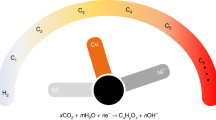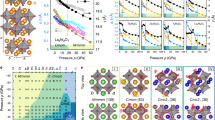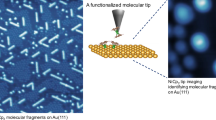Abstract
Transition metals (TMs) typically exhibit rich redox chemistry and can be found in various oxidation states. In most cases, TMs are positively charged. Strong π-accepting ligands have been shown to stabilize molecular complexes with TMs in formal negative oxidation states. By contrast, organic-ligand-free TM anions remain rare, limited to intermetallic compounds based on third-row TMs such as gold or platinum. Here we report the synthesis of air-stable lanthanide–nickel molecular intermetallic complexes featuring a ligand-free Ni2− confined within fullerenes, namely, Tb2Ni@C82. The charged Tb2Ni lanthanide nickelide cluster forms metal-only Lewis pairs, featuring strongly polarized Tb–Ni covalent bonds with short bond lengths in the range of 2.50–2.57 Å. X-ray absorption spectroscopy supports the −2 oxidation state of Ni with 3d104s2 electron count, in line with the spectroscopic and magnetic measurements, and theoretical study. This finding opens up an efficient way to stabilize intermetallic clusters with elusive nucleophilic TM anions by confining them inside molecular carbon cages.

This is a preview of subscription content, access via your institution
Access options
Access Nature and 54 other Nature Portfolio journals
Get Nature+, our best-value online-access subscription
27,99 € / 30 days
cancel any time
Subscribe to this journal
Receive 12 print issues and online access
269,00 € per year
only 22,42 € per issue
Buy this article
- Purchase on SpringerLink
- Instant access to full article PDF
Prices may be subject to local taxes which are calculated during checkout



Similar content being viewed by others
Data availability
All data supporting the findings of this study are available from the article and its Supplementary Information files. The XAS data, the coordinates of the calculated structures and the data of the cluster-based LMOs have been deposited to Zenodo with the dataset identifier: https://doi.org/10.5281/zenodo.14919092 (ref. 48). Data are also available from the corresponding authors upon reasonable request. Crystallographic data for the structures reported in this article have been deposited at the Cambridge Crystallographic Data Centre, under deposition numbers CCDC 2360128 (1), 2360129 (2), 2406091 (Y2Ni@C3v(8)-C82) and 2406092 (Y2Ni@Cs(6)-C82). Copies of the data can be obtained free of charge via https://www.ccdc.cam.ac.uk/structures/. Source data are provided with this paper.
References
Sunderlin, L., Wang, D. & Squires, R. R. Bond strengths in first-row-metal carbonyl anions. J. Am. Chem. Soc. 115, 12060–12070 (1993).
Mokhtarzadeh, C. C., Moore, C. E., Rheingold, A. L. & Figueroa, J. S. Terminal iron carbyne complexes derived from arrested CO2 reductive disproportionation. Angew. Chem. Int. Ed. 56, 10894–10899 (2017).
Brennessel, W. W. & Ellis, J. E. [Fe(CNXyl)4]2−: an isolable and structurally characterized homoleptic isocyanidemetalate dianion. Angew. Chem. Int. Ed. 46, 598–600 (2007).
Margulieux, G. W. et al. Isocyano analogues of [Co(CO)4]n: a tetraisocyanide of cobalt isolated in three states of charge. J. Am. Chem. Soc. 132, 5033–5035 (2010).
Gao, Y., Li, G. & Deng, L. Bis(dinitrogen)cobalt(−1) complexes with NHC ligation: synthesis, characterization, and their dinitrogen functionalization reactions affording side-on bound diazene complexes. J. Am. Chem. Soc. 140, 2239–2250 (2018).
Chi, C. et al. Alkali metal covalent bonding in nickel carbonyl complexes ENi(CO)3−. Angew. Chem. Int. Ed. 58, 1732–1738 (2019).
Blake, M. P., Kaltsoyannis, N. & Mountford, P. Probing the limits of alkaline earth–transition metal bonding: an experimental and computational study. J. Am. Chem. Soc. 137, 12352–12368 (2015).
Vollmer, M. V. et al. Formal nickelate(-I) complexes supported by group 13 ions. Angew. Chem. Int. Ed. 57, 7815–7819 (2018).
Jansen, G. et al. Unsupported Ti–Co and Zr–Co bonds in heterobimetallic complexes: a theoretical description of metal–metal bond polarity. J. Am. Chem. Soc. 120, 7239–7251 (1998).
Wang, J. Q. et al. Multiple bonding between group 3 metals and Fe(CO)3−. Angew. Chem. Int. Ed. 59, 2344–2348 (2020).
Wang, P. et al. Selective hydroboration of terminal alkynes catalyzed by heterometallic clusters with uranium–metal triple bonds. Chem 8, 1361–1375 (2022).
Jansen, M. The chemistry of gold as an anion. Chem. Soc. Rev. 37, 1826–1835 (2008).
Sommer, A. Alloys of gold with alkali metals. Nature 152, 215 (1943).
Karpov, A., Nuss, J., Wedig, U. & Jansen, M. Cs2Pt: a platinide(−II) exhibiting complete charge separation. Angew. Chem. Int. Ed. 42, 4818–4821 (2003).
Karpov, A., Nuss, J., Wedig, U. & Jansen, M. Covalently bonded [Pt]-chains in BaPt: extension of the Zintl−Klemm concept to anionic transition metals? J. Am. Chem. Soc. 126, 14123–14128 (2004).
Chaboy, J. et al. X-ray absorption in Ce(Fe1−xCox)2 and Ce(Fe1−xAlx)2 compounds. Phys. Rev. B 62, 468–475 (2000).
Burns, C. P. et al. Structure and magnetization dynamics of Dy–Fe and Dy–Ru bonded complexes. Angew. Chem. Int. Ed. 57, 8144–8148 (2018).
Ramirez, B. L., Sharma, P., Eisenhart, R. J., Gagliardi, L. & Lu, C. C. Bimetallic nickel-lutetium complexes: tuning the properties and catalytic hydrogenation activity of the Ni site by varying the Lu coordination environment. Chem. Sci. 10, 3375–3384 (2019).
Butovskii, M. V. et al. Molecules containing rare-earth atoms solely bonded by transition metals. Nat. Chem. 2, 741–744 (2010).
Magott, M., Brzozowska, M., Baran, S., Vieru, V. & Pinkowicz, D. An intermetallic molecular nanomagnet with the lanthanide coordinated only by transition metals. Nat. Commun. 13, 2014 (2022).
Popov, A. A., Yang, S. & Dunsch, L. Endohedral fullerenes. Chem. Rev. 113, 5989–6113 (2013).
Hu, Z. & Yang, S. Endohedral metallofullerene molecular nanomagnets. Chem. Soc. Rev. 53, 2863–2897 (2024).
Krätschmer, W., Lamb, L. D., Fostiropoulos, K. & Huffman, D. R. Solid C60: a new form of carbon. Nature 347, 354–358 (1990).
Buschow, K. Intermetallic compounds of rare-earth and 3d transition metals. Rep. Prog. Phys. 40, 1179 (1977).
Xu, Y.-Y. et al. Flexible decapyrrylcorannulene hosts. Nat. Commun. 10, 485 (2019).
Pyykkö, P. Additive covalent radii for single-, double-, and triple-bonded molecules and tetrahedrally bonded crystals: a summary. J. Phys. Chem. A 119, 2326–2337 (2015).
Fang, W., Zhu, Q. & Zhu, C. Recent advances in heterometallic clusters with f-block metal–metal bonds: synthesis, reactivity and applications. Chem. Soc. Rev. 51, 8434–8449 (2022).
Ramirez, B. L. & Lu, C. C. Rare-earth supported nickel catalysts for alkyne semihydrogenation: chemo- and regioselectivity impacted by the Lewis acidity and size of the support. J. Am. Chem. Soc. 142, 5396–5407 (2020).
Xu, W. et al. An experimentally observed trimetallofullerene Sm3@Ih-C80: encapsulation of three metal atoms in a cage without a nonmetallic mediator. J. Am. Chem. Soc. 135, 4187–4190 (2013).
Wang, Y. et al. Electrophilic trifluoromethylation of dimetallofullerene anions en route to air-stable single-molecule magnets with high blocking temperature of magnetization. J. Am. Chem. Soc. 143, 18139–18149 (2021).
Chen, C.-H. et al. Selective arc-discharge synthesis of Dy2S-clusterfullerenes and their isomer-dependent single molecule magnetism. Chem. Sci. 8, 6451–6465 (2017).
Cutsail Iii, G. E. & DeBeer, S. Challenges and opportunities for applications of advanced X-ray spectroscopy in catalysis research. ACS Catal. 12, 5864–5886 (2022).
Yang, H. B. et al. Atomically dispersed Ni(I) as the active site for electrochemical CO2 reduction. Nat. Energy 3, 140–147 (2018).
Geoghegan, B. L. et al. Combining valence-to-core X-ray emission and Cu K-edge X-ray absorption spectroscopies to experimentally assess oxidation state in organometallic Cu (I)/(II)/(III) complexes. J. Am. Chem. Soc. 144, 2520–2534 (2022).
Bader, R. F. Atoms in molecules. Acc. Chem. Res. 18, 9–15 (1985).
Dunsch, L. et al. Metal sulfide in a C82 fullerene cage: a new form of endohedral clusterfullerenes. J. Am. Chem. Soc. 132, 5413–5421 (2010).
Sheldrick, G. Crystal structure refinement with SHELXL. Acta Crystallogr. C 71, 3–8 (2015).
Dolomanov, O. V., Bourhis, L. J., Gildea, R. J., Howard, J. A. K. & Puschmann, H. OLEX2: a complete structure solution, refinement and analysis program. J. Appl. Crystallogr. 42, 339–341 (2009).
Hu, Z. et al. High-temperature magnetic blocking in a monometallic dysprosium azafullerene single-molecule magnet. Chem 9, 3613–3622 (2023).
Xin, J. et al. Short didysprosium covalent bond enables high magnetization blocking temperature of a direct 4f–4f coupled dinuclear single-molecule magnet. J. Am. Chem. Soc. 146, 17600–17605 (2024).
Chilton, N. F., Anderson, R. P., Turner, L. D., Soncini, A. & Murray, K. S. PHI: a powerful new program for the analysis of anisotropic monomeric and exchange-coupled polynuclear d- and f-block complexes. J. Comput. Chem. 34, 1164–1175 (2013).
Gaussian 09 v. Revision D.01 (Gaussian, Inc., 2009).
Lee, C., Yang, W. & Parr, R. G. Development of the Colle–Salvetti correlation-energy formula into a functional of the electron density. Phys. Rev. B 37, 785–789 (1988).
Grimme, S., Antony, J., Ehrlich, S. & Krieg, H. A consistent and accurate ab initio parametrization of density functional dispersion correction (DFT-D) for the 94 elements H-Pu. J. Chem. Phys. 132, 154104 (2010).
Grimme, S., Ehrlich, S. & Goerigk, L. Effect of the damping function in dispersion corrected density functional theory. J. Comput. Chem. 32, 1456–1465 (2011).
Lu, T. & Chen, F. W. Multiwfn: a multifunctional wavefunction analyzer. J. Comput. Chem. 33, 580–592 (2012).
Fdez. Galván, I. et al. OpenMolcas: from source code to insight. J. Chem. Theory Comput. 15, 5925–5964 (2019).
Chuai, P. et al. Data from the manuscript: ‘Lanthanide–nickel molecular intermetallic complexes featuring a ligand-free Ni2− anion in endohedral fullerenes’. Zenodo https://doi.org/10.5281/zenodo.14919092 (2025).
Acknowledgements
This work was supported by the National Natural Science Foundation of China (22275002 to Z.S., 52302052 to Z.H., 51925206 to S.Y. and U1932214 to S.Y.), the National Basic Research Program of China (2017YFA0204901 to Z.S.), the Strategic Priority Research Program of the Chinese Academy of Sciences (XDB0450301 to S.Y.), the Fundamental Research Funds for the Central Universities (20720220009 to S.Y. and WK2060000093 to Z.H.), the Anhui Provincial Natural Science Foundation (2308085MB33 to Z.H.), the National Synchrotron Radiation Laboratory (KY2060000240 to Z.H.) and the Spanish MCIU (2D-SPICE PID2023-149309OB-I00, co-financed by FEDER, to E.C. and Excellence Unit ‘María de Maeztu’ CEX2024-001467-M to E.C.). We thank the staff in the BL17B beamline of the National Facility for Protein Science Shanghai (NFPS) and BL14W1 X-ray absorption fine structure spectroscopy (XAFS) beamline at the Shanghai Synchrotron Radiation Facility for assistance during data collection.
Author information
Authors and Affiliations
Contributions
Z.H., E.C., S.Y. and Z.S. conceived and designed the experiments. P.C., Z.H., Y.-R.Y. and Z.J. performed the experiments and carried out the analysis. Z.H. and A.U. performed the theoretical studies. Y.Z., W.C. and M.C. contributed to the synthesis, X-ray absorption analysis and crystallographic characterizations. All authors discussed the results and commented on the paper.
Corresponding authors
Ethics declarations
Competing interests
The authors declare no competing interests.
Peer review
Peer review information
Nature Chemistry thanks the anonymous reviewers for their contribution to the peer review of this work.
Additional information
Publisher’s note Springer Nature remains neutral with regard to jurisdictional claims in published maps and institutional affiliations.
Extended data
Extended Data Fig. 1 Molecular structures of Y2Ni@C3v(8)-C82 and Y2Ni@Cs(6)-C82.
a,b Thermal ellipsoid plots of Y2Ni@C3v(8)-C82·NiIIOEP·C6H6 (a) and Y2Ni@Cs(6)-C82·2(DPC)·2C7H8 (b); only the major sites of Y and Ni are shown, and the solvent molecules are omitted for clarity. c,d Front views of Y2Ni@C3v(8)-C82 (c) and Y2Ni@Cs(6)-C82 (d). e,f Close-up views of the Y2Ni clusters and the adjacent cage fragments in Y2Ni@C3v(8)-C82 (e) and Y2Ni@Cs(6)-C82 (f), annotated with experimental Y–Ni bond lengths, Y-to-ring centroid and Y-to-bond centroid distances, and Y–Ni–Y angles. Y is represented by green, Ni by yellow, C by gray and N by cyan.
Supplementary information
Supplementary Information
Supplementary Figs. 1–30 and Tables 1–14.
Supplementary Data 1
Coordinates of the optimized structure of compound 2 (Supplementary Fig. 26).
Supplementary Data 2
Coordinates of the optimized structure of Y2Ni@C3v(8)-C82 (Supplementary Fig. 29).
Supplementary Data 3
Coordinates of the optimized structure of Y2Ni@Cs(6)-C82 (Supplementary Fig. 30).
Supplementary Data 4
Coordinates of the optimized structure of compound 1 (Fig. 3).
Supplementary Data 5
Crystallographic data for compound 1 (CCDC 2360128).
Supplementary Data 6
Crystallographic data for compound 2 (CCDC 2360129).
Supplementary Data 7
Crystallographic data for Y2Ni@C3v(8)-C82 (CCDC 2406091).
Supplementary Data 8
Crystallographic data for Y2Ni@Cs(6)-C82 (CCDC 2406092).
Source data
Source Data Fig. 2
Data of normalized X-ray absorption spectra and their derivatives of compounds 1 and 2 and reference compounds of Ni and Tb.
Rights and permissions
Springer Nature or its licensor (e.g. a society or other partner) holds exclusive rights to this article under a publishing agreement with the author(s) or other rightsholder(s); author self-archiving of the accepted manuscript version of this article is solely governed by the terms of such publishing agreement and applicable law.
About this article
Cite this article
Chuai, P., Hu, Z., Yao, YR. et al. Lanthanide–nickel molecular intermetallic complexes featuring a ligand-free Ni2− anion in endohedral fullerenes. Nat. Chem. (2025). https://doi.org/10.1038/s41557-025-01802-2
Received:
Accepted:
Published:
DOI: https://doi.org/10.1038/s41557-025-01802-2



